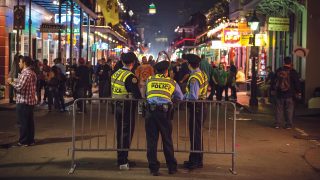
While training to be a crisis negotiator, I came across this quote from Sergeant Matt Lyons of the Queensland Police Service in Australia. He said:
“There are no words to describe the feeling of having someone else’s life in your own hands, whether it’s standing face to face or 286 meters on the side of Castle Hill. Maybe it’s speaking by phone while they’re holding a loaded gun. It could be someone unwell, holding a knife, out of luck, begging for reasons to live. As a negotiator, you pray that you find the right words that ultimately prove successful in times of crisis.”
Almost every police officer during their career will encounter some type of similar situation. These encounters are often very tense and potentially dangerous. Officers are well-trained regarding the use of deadly force and less-lethal weaponry, if necessary, to protect lives and resolve critical situations. However, not all encounters of this nature with people in crisis need to end in this manner. One of the best skills and tools on their toolbelt is the ability to communicate and resolve these intense situations without resorting to either physical or deadly force. That is the art of de-escalation. There is nothing more rewarding than ending a critical incident with the peaceful surrender of the individual in crisis.
The actions of any police officer in an instant can impact an individual or family for life and a community for years to come. Officers have the power and authority to use force, up to and including deadly force. It is all too often headlines will portray an incident where force was excessive or used too quickly with the wrong intent.
Police de-escalation is a set of tactics and strategies that law enforcement uses to reduce the need for force, or the amount of force required, to resolve a potentially volatile situation. The goal is to stabilize the situation and reduce the threat so that more time and resources can be used to resolve the situation without force. The National Consensus Policy specifically defines police de-escalation as “taking action or communicating verbally or nonverbally during a potential force encounter in an attempt to stabilize the situation and reduce the immediacy of the threat so that more time, options and resources can be called upon to bring the matter to a successful conclusion. Your safety and the safety of others is the highest priority.
De-escalation can help officers improve their ability to manage people and situations, build rapport and positively influence individuals to peacefully resolve calls for service. De-escalation helps officers stay focused and calm during dynamic situations and enhances trust-based relationships.
Some de-escalation techniques include empathy and reserving judgment. Officers should try to meet people where they are and find something in common. One should maintain a calming presence and ensure their body language or other nonverbal communication is relaxed and in control.
Set limits, but pick your battles. Getting someone to surrender peacefully can take a long time and require several steps. Remember that time is on your side if things are moving in a positive direction. Respect their personal space and maintain a safe distance. If possible, remove people from the area, including parties to the conflict and onlookers.
The best strategies to de-escalate a situation are to actively listen to and identify what the issue is and the person’s concerns. Offer reflective comments to show that you have heard what their concerns are. Wait until the person has released their frustration and explained how they are feeling. Confirm that you are listening and express empathy to show you understand. It is not your job to stop the person from being angry, but these steps may help to make the person feel calmer. It is only then that you can look at how to deal with the situation and their concerns.
Periods of intense anger do not last long. Intense feelings like anger naturally dissipate as time passes. When there are signs of anger or verbal aggression, it is important to remember that you need to stay calm. Anger may be a sign that the person is in distress or experiencing fear or frustration. It is not possible to reason or problem-solve with someone who is enraged. When emotions run high, logic and reason are diminished.
There is nothing more rewarding than ending a critical incident by the peaceful surrender of the individual in crisis.
Wait until the person has released their frustration and explained how they are feeling. Active listening is a key component of de-escalation. It requires more than just hearing words. One must try to determine the meanings behind those words. Determine what are the unspoken feelings or needs of the individual. Listen to clues. Most officers may be planning what they are going to say next and miss these clues. You must suspend all judgment and actively listen to all they have to say. The idea is to let them know you hear them and are there for them. Remember that empathy is different than sympathy. They usually do not want you to feel sorry for them as much as they want you to just understand their perspective.
Some methods to build trust and rapport include emotional labeling like, “You sound like,” “It seems like,” or “What I’m hearing is.” It is soothing for a person in crisis when you name the emotion because it normalizes their feelings. Examples are “You sound upset because your wife left you” or “What I’m hearing is that you are angry because your boss fired you unfairly.”
Another good technique is to repeat something they said by using their exact words. It verifies that you are listening. Try to use their last three or four words. An example is when the individual ends a sentence with “I’m tired of the bullshit,” one can interject “Tired of the bullshit?” and pause. It slows the conversation down so they feel safe. It gives the caller a cue to add more and helps the listener gather more information through simple repetition. Another method is to paraphrase what they say using similar words only as you summarize what you have heard. Try saying, “Let me see if I got this right” or “What you’re saying is …”
The listener can also use reflection to explain what they said using their own words and attaching emotion to the person. This allows you to reflect on the person’s situation and experiences as well as their response to those experiences. Use open-ended questions that can’t be answered with a yes or no, a number or a simple answer. This gives the person an idea that they must participate. Be careful when starting a question with “Why?” This may cause the individual to get sidetracked and down a bunny hole. Open-ended questions can make them feel in control and provide an opportunity for the officer to discover new details, eliminating incorrect assumptions.
Examples of closed-ended questions are “How long have you been out of jail?” or “What were your charges?” An open-ended question can be as simple as “What happened today? or “Tell me more about that.”
When the officer is close to gaining compliance, he can summarize and condense the story and recap what he heard, including feelings and circumstances. This will clarify that you got it right. Be careful using self-disclosure. It should only be used if it helps the person feel more comfortable with you, allowing you to more effectively guide their decision-making.
Common ground can include disclosing true-life experiences that are very similar to the person’s. Be careful because the caller may keep pushing to get more details. It can also demonstrate that you have been listening and that you truly understand and are willing to help the person move forward and end this dilemma.
The Law Enforcement De-escalation Training Act of 2022 directs the U.S. Department of Justice to develop or identify effective existing training for law enforcement officers and covered mental health professionals regarding (1) employing de-escalation tactics and alternatives to use of force; (2) safely responding to an individual experiencing a mental or behavioral health or suicidal crisis or an individual with a disability, including techniques and strategies that are designed to protect the safety of that individual, law enforcement officers, mental health professionals and the public; (3) successfully participating on a crisis intervention team; and (4) making referrals to community-based mental and behavioral health services and support, housing assistance programs, public benefits programs, the National Suicide Prevention Lifeline and other services.
De-escalation should be included and consistent with a police department’s use-of-force policy. Department personnel shall use de-escalation techniques to gain voluntary compliance from an individual and reduce or eliminate the need to use force. When feasible, sworn personnel shall identify themselves as “police” and announce their intent to detain, search or arrest an individual before using force when it is not plainly obvious that they are a law enforcement officer by virtue of their uniform and equipment or by the circumstances of the contact with the individual. When working in a plainclothes capacity, sworn personnel shall verbally identify themselves as “police.”
Department personnel shall recognize and use distance, cover, concealment or intermediate barriers to maximize their reaction time and deployment of resources. When feasible, prior to making initial contact with an individual in response to a high-threat situation, department personnel shall take time to plan how they will respond to the situation, plan de-escalation techniques, and create a force array. At the scene of a potentially violent encounter, officers should attempt to use all available resources to avoid resolving the incident or situation independently unless there is a threat of death or serious physical injury.
Only one officer should be designated to verbally interact with a subject. Too many officers pointing weapons and yelling out commands can only make matters confusing and worsen the situation. A force array should include less-lethal weaponry, a police K-9 and officers with long guns at the ready, but essentially at a distance so as not to be a distraction to the person in crisis.
Allow an individual an objectively reasonable amount of time to submit to arrest or a lawful order before using force. Remember that time is to your advantage if the interaction is moving in a positive direction. Consider whether an individual’s failure to comply with their commands or de-escalation efforts is due to a medical condition, mental impairment, physical limitation, developmental disability, language barrier, drug interaction, behavioral crisis or other factors beyond the individual’s control. Consider whether specific techniques or resources would help resolve the situation without resorting to force. Department personnel shall take reasonable steps under the circumstances, before and during any use of force, to avoid unnecessary risk to themselves, victims, hostages and other individuals.
The preface to the standard operating use-of-force policies of many police departments contains a statement to the effect of respecting the sanctity of human life when making decisions regarding the use of force. The communication skills, patience, empathy and compassion displayed today by our trained professional police officers have deflected countless situations that may not otherwise have had peaceful conclusions.
Police officers should always strive to uphold lawful, professional and ethical standards. To do so would ensure that procedural justice was maintained while averting unnecessary uses of force by establishing trust, clear intent and developing rapport. Using de-escalation clearly reflects the professionalism of a department and can prevent negative media attention and potential liability. As Peter Parker (aka Spiderman) once said, “With great power comes great responsibility.” Exhibiting restraint and respect for the sanctity of human life and avoiding unnecessary or unreasonable uses of force in critical incidents will go a long way toward gaining trust in our communities.
As seen in the February 2025 issue of American Police Beat magazine.
Don’t miss out on another issue today! Click below:





